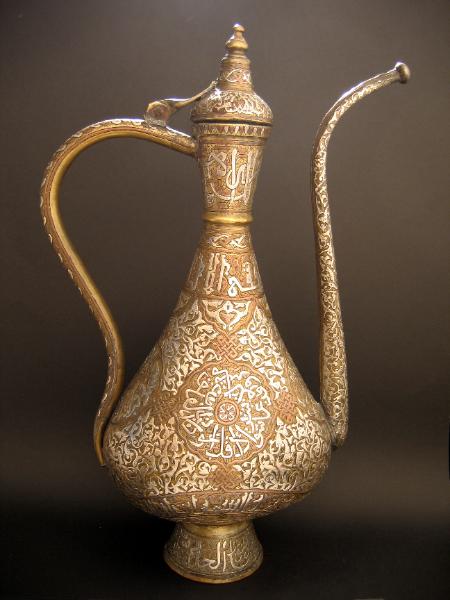Cairoware Ewer

A Massive Inlaid Brass Ewer made for the Central Asian Market
late 19th century
height: 57 cm
This large pear-shaped ewer inlaid with silver and copper and with an S-shaped handle, tall spout and flared foot is decorated with motifs typical of Central Asian Islamic art. Most notable are 13 sizeable and complete Buddhist endless knots in inlaid copper. The knots are not stylised or suggested but are remarkably prominent. The four large bracket-lobed calligraphic cartouches from which the knots hang like pendants around the body of the ewer have at their centres roundels in which two Greek crosses, one in copper, the other in silver, are laid over one another. The lip of the rim of the ewer is inlaid with lotus petal-like motifs in alternate copper and silver. And the long handle is inlaid with silver and copper in a typically Timurid-style interlacing band. Each of these elements is typical of Central Asian metalwork. The ewer is also decorated with calligraphic roundels and bands of inscriptions in
Naskhi script amid scrolling inlaid, silver palmettes that have been further engraved. The inscriptions include various Koranic verses and sayings.
The work on this ewer is similar to that done in Egypt and Syria in the late 19th and early 20th centuries. However, the style and motifs suggest a different provenance, more likely Turkmenistan or Uzbekistan.
Central Asia was linked to China by trade routes collectively known as the Silk Road and so the Islamic art of the region incorporated typically Chinese motifs not found in Islamic work elsewhere. Professor Johannes Kalter in his essay ‘Is there a distinctive Central Asian type of Islamic Art?’ in
Uzbekistan: Heirs to the Silk Road (Thames & Hudson, 1997) describes the Buddhist endless knot as a “leitmotif” for determining Central Asian origins in Islamic art. “Another typical Central Asian feature are circular medallions filled with quartered plant motifs to suggest a Greek cross,” says Kalter. The motif survives to this day in Central Asian art, possibly refers to the four elements: fire, water, earth and air. Bracket-lobed cartouches with a geometric design terminating in trefoils or endless knots are also typical of Central Asian provenance; bracket-lobed cartouches being reminiscent of stylised cloud motifs common in Chinese art. All these elements that Kalter attributes to a Central Asian provenance are present in this one, remarkable ewer.
Inventory no.: 7
SOLD

